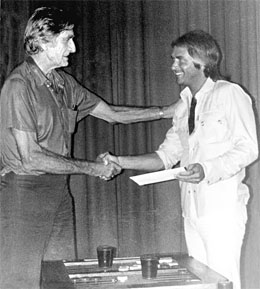|
| Magriel's NYT Columns |

Alexis Obolensky awards the
Champion’s Trophy to Tony Goble
(right) at a tournament in Mexico. Backgammon has become increasingly popular in the Southwest, which boasts a number of expert players. Foremost among these is Tony Goble, a top-ranked international competitor. Goble gained in stature in 1976, when his overall tournament record surpassed everyone else’s. That year, in addition to winning major tournaments in San Francisco and Chicago, he took the World Grandmaster’s Cup in Las Hadas, Mexico.
Last week at the monthly regional tournament in Dallas, sponsored by the Texas Backgammon Association, Goble placed second to Charles Pipkin. During one of the early rounds, Goble profited when his opponent made a commonplace error.
In the diagrammed position, Goble (White) had already doubled. He had borne off 9 men and was on his way to winning at least a gammon, unless one of his last men was hit. However, Goble’s opponent (Black), still hadn’t given up hope of winning the game, when he rolled a 5-3.
|
| Black to play 5-3. |
|
| Black to play 6-1. |
Although Black was certainly unlucky, he needn’t have been backgammoned if he had played the 5-3 accurately.
The correct play for Black with the 5-3 is 24/16, taking one man out of White’s home board immediately in order to reduce the chance of being gammoned to a minimum. Saving the backgammon should be Black’s first priority — not strengthening his home board.
If Black is fortunate enough both to get a shot and hit White, Black will be a favorite to close his opponent out. Furthermore, keeping a second man back on White’s 1-point is of little value; the exact same number of combinations that force White to leave a shot next roll will come up whether Black has one or two men back on the 24-point.
Backgammons are rare, and players who are backgammoned usually feel beset by ill fortune. Nevertheless, many backgammons are gratuitous. By taking timely countermeasures, they can often be avoided.
Rollout
 Tom Keith 2013 |
|
Money play Black owns 2-cube Black rolls 5-3 1296 games with VR Checker play: 2-ply Cube play: 3-ply Red |
| 5-3: | Game | G | BG | Equity | ||||
| 1 | 24/16 |
W L |
.0830 .9170 |
.0000 .8006 |
.0000 .0954 | −1.6961 |

| |
| 2 | 13/5 |
W L |
.1019 .8981 |
.0000 .7053 |
.0000 .2482 | −1.7049 | (0.0088) |

|
|

